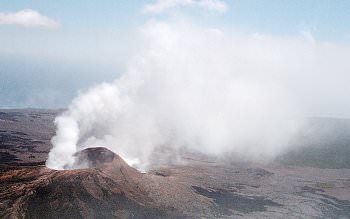[/caption]
The material that erupts out of a volcano starts as magma deep underground. Much of this magma is rock, but it can also contain pockets of volcanic gas dissolved into it. As the magma rises up, these dissolved gasses begin to form tiny bubbles as the pressure gets lower. As it gets closer to the surface, the bubbles increase in number and size creating additional pressure inside the volcano.
The volcanic gas undergoes a tremendous increase in volume when the magma reaches the surface and erupts. This expansion can be the driving force of explosive eruptions.
The primary components in volcanic gas are water vapor, carbon dioxide and sulfur (either sulfur dioxide or hydrogen sulfide). But you can also find nitrogen, argon, helium, neon, methane, carbon dioxide and hydrogen. Approximately 60% of total emissions released by volcanoes is water vapor, and carbon dioxide accounts for 10 to 40% of emissions. Although that sounds like a candidate for greenhouse gases, volcanoes actually contribute only 1% of the carbon dioxide released into the atmosphere every year.
You might be surprised to know that poisonous gases were responsible for about 3% of all volcano-related deaths from 1900 to 1986. Some people were killed by acidic corrosion (ouch) while others were asphyxiated.
We have written many articles about volcanoes for Universe Today. Here’s an article about different types of volcanoes, and here’s an article about the biggest volcano in the Solar System.
Want more resources on the Earth? Here’s a link to NASA’s Human Spaceflight page, and here’s NASA’s Visible Earth.
We have also recorded an episode of Astronomy Cast about Earth, as part of our tour through the Solar System – Episode 51: Earth.

